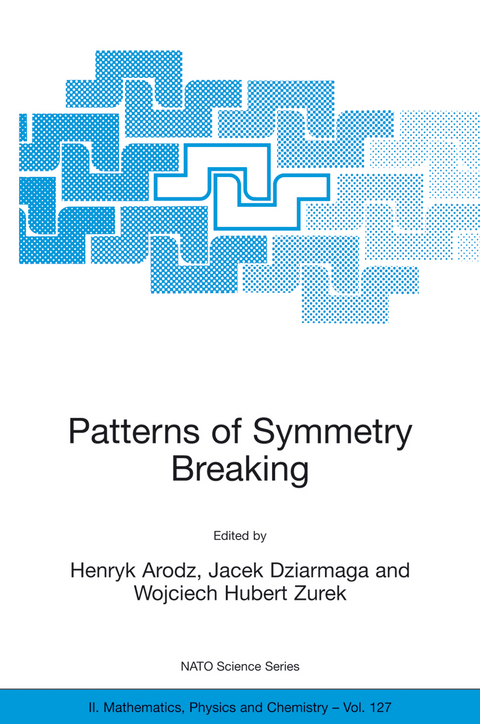
Patterns of Symmetry Breaking
Springer-Verlag New York Inc.
978-1-4020-1744-5 (ISBN)
The conceptofspontaneous symmetry breaking plays a fundamental role in contemporary physics. It is essential for the description of degenerate ground states, massless modes, and topological defects. Examples are abundant in condensed matter physics, atomic and particle physics, as well as in astro physics and cosmology. In fact, spontaneous symmetry breaking can be re garded as a cornerstone ofa whole branch ofphysics which intersects the above mentioned traditionally distinct fields. In the year 2000 the European Science Foundation (ESF) started the Pro gramme "Cosmology in the Laboratory" (COSLAB), with the goal to search for and to develop analogies betweencondensed matterphysics, particle physics, and cosmology. Not surprisingly, spontaneous symmetry breaking is among the most useful notions in that endeavour. It has been decided that in the sec ond year of the Programme a School should be held in order to work out and deliver to a wide audience of students synthetic overviews of achievements and of current research topics of COSLAB. This idea has been supported by the Scientific and Environmental Affairs Division of NATO by including the School in the renowned series of its Advanced Study Institutes. The School, entitled" Patterns of Symmetry Breaking", was held in Cracow during 16-28 September 2002. It gathered 17 lecturers and about 60 students. The present volume contains notes ofmost of the lectures from that School. We hope that of the physics of spon it will convey to the reader the breadth and the beauty taneous symmetry breaking.
Symmetry Breaking and Defects.- Acknowledgments.- References.- Liquid 4He and Its Superfluidity.- Acknowledgments.- References.- The Role of Topological Defects in Cosmology.- References.- Cosmic Defects and Particle Physics Constraints.- 4.3.1 Theory-F.- 4.3.2 Theory-D.- 5.1.1 Scaling Cosmic Strings.- 5.1.2 Friction Dominated Strings.- 5.1.3 Vortons.- 6.2.1 Constraints.- References.- to the Modern Theory of Phase Transitions.- 1 Phase Transitions: From Early Universe to Ice Cube.- 2 Spontaneous Symmetry Breaking.- 3 Symmetry and Phase Transitions. Order Parameter.- 4 Fluctuations.- 5 Power laws - Saint Graal of the complex system science.- 6 Scaling.- 7 Renormalization Group.- 8 Final remarks.- References.- Defects in Liquid Crystals: Surface and Interracial Anchoring Effects.- 1 Introduction.- 2 Experimental observations of LC structures.- 3 Defects in nematics.- 4 Defects in SmA and other Lamellar Systems.- 5 Summary.- Acknowledgments.- References.- Scaling Laws for Fluxon Formation in Annular Josephson Tunnel Junctions.- 1 Scaling Laws for Fluxon Production.- 2 The Experiment.- 3 The results.- 4 Comments, Future Experiments and Conclusions.- Acknowledgments.- References.- Nonholonomic Field Theory of Vortices and Defect and their Physe Transitions.- 1 Summary.- 2 Phase Transitions in Nambu-Goldstone Systems.- 3 Superfluid 4He and Superconductors.- 4 Abelian Quark Confinement.- References.- 5 Superfluid 4He.- 6 Crystals.- 7 Abelian Quark Confinement.- Acknowledgments.- References.- Vortices and Flat Directions: the Uses of Bogomolnyi Bounds.- 1 Introduction.- 2 Energy bounds for topological defects.- 3 Bogomolnyi bounds for Abrikosov-Nielsen-Olesen vortices.- 4 Semilocal strings.- 5 D-term super symmetric QED.- 6 Bogomolnyi bounds, supersymmetry and fermion zero modes.- 7 Summary.- References.- Evolution of Local Vortices and Interfaces.- 1 Introduction.- 2 Simple example - kink in one spatial dimension.- 3 Vortex in the Abelian Higgs model.- 4 Evolution of interface in a dissipative system.- 5 Remarks.- References.- Non-Equilibrium Mott Transition in a lattice of Bose-Einstein condensates.- 1 Introduction.- 2 Josephson junction arrays.- 3 The quantum phase model.- 4 Linear Quench.- 5 The gaussian regime.- 6 The critical regime.- 7 From superfluid to insulating phase.- 8 Conclusion.- Acknowledgments.- References.- Spontaneous Breakdown of chiral symmetry in QCD.- Acknowledgments.- References.- Domain Wall Solutions.- 1 Introduction.- 2 The kink.- 3 SU(5) × Z2 walls.- References.- Phenomenology of Effective Gravity.- 1 Introduction.- 2 Gravity as perturbation of quantum vacuum.- 3 Robertson-Walker metric and its energy momentum tensor.- 4 Einstein static Universe.- 5 de Sitter solution as a thermodynamic equilibrium state.- 6 Phenomenology of Godel Universe.- 7 Modification of Einstein equation and relaxation of the vacuum energy.- 8 On energy and momentum of gravitational waves.- 9 Discussion.- Acknowledgments.- References.
| Erscheint lt. Verlag | 30.11.2003 |
|---|---|
| Reihe/Serie | NATO Science Series II: Mathematics, Physics and Chemistry ; 127 |
| Zusatzinfo | 10 Illustrations, black and white; X, 404 p. 10 illus. |
| Verlagsort | New York, NY |
| Sprache | englisch |
| Maße | 155 x 235 mm |
| Themenwelt | Naturwissenschaften ► Physik / Astronomie ► Atom- / Kern- / Molekularphysik |
| Naturwissenschaften ► Physik / Astronomie ► Festkörperphysik | |
| Naturwissenschaften ► Physik / Astronomie ► Thermodynamik | |
| ISBN-10 | 1-4020-1744-8 / 1402017448 |
| ISBN-13 | 978-1-4020-1744-5 / 9781402017445 |
| Zustand | Neuware |
| Haben Sie eine Frage zum Produkt? |
aus dem Bereich


